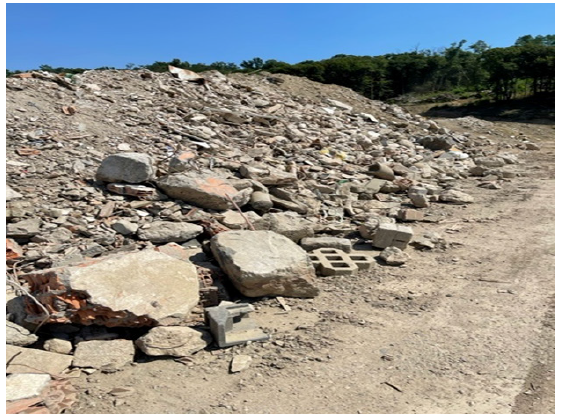- Submissions

Full Text
COJ Technical & Scientific Research
Recycled Concrete with Mixed Granulate Material: Still a Future Perspective?
Christian Paglia*
University of Applied Sciences of Southern Switzerland, Switzerland
*Corresponding author: Christian Paglia, University of Applied Sciences of Southern Switzerland, Supsi, V. Flora Ruchat 15, 6850 Mendrisio, Switzerland
Submission: September 16, 2022; Published: September 28, 2022

Volume3 Issue5September , 2022
Introduction
The use of concrete is worldwide largely widespread. A relevant ingredient is cement. The production of cementitious binders is often related to an increase in the CO2 production. In order to limit the environmental pollution, the presence of CO2 must be limited. A huge effort is ongoing toward more sustainable cementitious materials [1-6]. This takes place in the production phase with alternative combustion products. In addition, to reduce the Portland cement component of the cementitious binders, several materials are largely added to the mixtures. Wastes alternatives, such as carbon, oil-shale, bio-mass, incinerator and sewage plant ashes and cement kiln dust are added in substitution. Glass, shredded tyres, plastics, textiles and other inorganic components are also used. Furthermore, the applied research is also currently focused on the use of supplementary cementitious materials, i.e., fly ashes, granulated blast furnace slags, nanosilica, silica fume, metakaolin, volcanic ashes and carbonate dusts [7]. Aluminate-calcium sulfoaluminate cements, alkali-activated binders, celite cements, Magnesium containing and calcined clay cements are also investigated.
Recycled Concrete
The concrete recycling process is a complimentary procedure to the above described, that contributes to the circular economy. This limits the landfill disposal and partially solve the lack of space, which was significantly reduced during the last decades [8]. In the last twenty years, the recycling of concrete became an important issue. Today a wide range of knowledge is present concerning the properties of recycled cementitious materials. In spite of the inhomogeneity of the recycled materials, adequate quality controls contribute to attain the required properties. The sieve curves of the granulates may fulfill the limits, while the fine component is largely limited in the content [9]. In fact, this latter fine material causes an increase in the water adsorption of the cementitious mixtures and its use needs to be clarified more in detail. On the other hand, the main characteristics of concrete, namely the compressive strength, may be achieved with recycled concrete [10]. This depends on the percentage of the recycled components added to the blends. However, values below 50 % allow to obtain a concrete with a compressive strength class C 25/30. Consequently, the materials may be used for the main building parts. Nevertheless, a wide skepticisms is still widely present in many construction professionals [11]. In the civil engineering field, the mechanical as well as the durability properties must be reached. Especially the requirements concerning the resistance to freeze / thaw, the chloride diffusion and the carbonation. This is possible by using demolished high-quality concrete or homogeneous crushed aggregates with known properties [12].
Recycled Mixed Granulate Concrete
Mixed inorganic demolition waste, in particular ceramic tiles, bricks, excavation material, stones and demolished concrete are often present simultaneously in the disposals. The use of these materials to prepare recycled concrete is done since decades. Nevertheless, the quality of this type of recycled concrete is questionable [13]. The inhomogeneity of this recycled concrete requires a more detailed and frequent control of the properties of the blends (Figure 1). The wide difference in the component’s features, creates even more doubts on the end quality. The compressive strength can reach values up to 20/25Mpa or higher depending on the percentage of the addition of the recycled mixed components. Until now, this type of recycled concrete is used for low quality part of structures, such as basements, small support walls or pipeline embedments. In this concern, the low homogeneity of this cementitious material does not allow further relevant applications in practice. For this reason, it will be necessary to sort part of the demolition debris, especially the ceramic component. This light weight and porous material could be used as a thermal insulating or fire resistance component or as an additional source of Aluminum in the production of cement-based materials. But it can no longer be treated as a concrete aggregate. In addition, the rocky wastes have to be sorted from the cementitious debris in order to get a more clear identification of the material type and expected quality. These three main components need to be accurately separated one another at the disposal stadium or during the demolition process. A future task that needs to be pursued to get a more clear construction and demolition waste management. At an initial phase this process is linked with higher costs, but on a mid-term basis it allows to gain usable high quality materials that can be re-directed to build high performance structures.
Figure 1:

Conclusion
The recycling of inert materials is a big challenge and needs to be done with care. The recycled materials already lived a life. Therefore, the contamination and the quality of the debris need to be controlled. It is possible to build infrastructures with recycled concrete, although the use of mixed granulates is no longer reasonable. A more selective demolition process must be implemented in the future and a re-thinking of some of the old composite construction systems are necessary to satisfy the recycling needs of the society and the future recycled concrete.
References
- Wang B, Yan L, Fu Q, Kasal B (2021) A comprehensive review on recycled aggregate and recycled aggregate concrete. Resources, Conservation & Recycling 171: 105565.
- Tam VWY, Soomro M, Jorge EAC (2018) A review of recycled aggregate in concrete applications (2000–2017). Construction and Building Materials 172: 272-292.
- Kabirifar K, Mojtahedi M, Wang C, Tam VWY (2020) Construction and demolition waste management contributing factors coupled with reduce, reuse, and recycle strategies for effective waste management: A review. Journal of Cleaner Production 263: 121265.
- Behera M, Bhattacharyya SK, Minocha AK, Deoliya R, Maiti S (2014) Recycled aggregate from C&D waste & its use in concrete - A breakthrough towards sustainability in construction sector: A review. Construction and Building Materials 68: 501-516.
- Benachio GLF, do Carmo M, Freitas D, Tavares SF (2020) Circular economy in the construction industry: A systematic literature review. Journal of Cleaner Production 260: 121046.
- Paglia C, Antonietti S, Mosca C (2021) Preliminary exploration of recycling cementitious aggregates in the building field. Proceedings of FTAL 28–29.
- Rafat Siddique, Paulo Cachim (2018) Plastic wastes, Waste and supplementary cementitious materials in concrete, A volume in Woodhead Publishing Series in Civil and Structural Engineering.
- (2006) Swiss Federal Office of the environment, Directive fir the recycling of the built mineral waste, Bern.
- (2021) Swiss Standard SIA 2030, Recycled concrete.
- Paglia C, Antonietti S, Mosca C (2022) The Known Quality of Concrete to Produce high Quality Recycled Cementitious Material, The 15th International Conference on Recent Advances in Concrete Technology and Sustainability Issues
- FSKB, ARV (2020) Mineral recycled building materials. Recommendations for clients, engineers, and architects.
- Paglia C, Paderi M, Mosca C, Antonietti S (2022) The recycling of a concrete with known properties to reproduce a durable material for the civil engineering infrastructure, Germany.
- Hoffmann C, Huth O (2006) Concrete from recycled aggregates, Swiss federal institute of material research and testing, Switzerland.
© 2022 Christian Paglia. This is an open access article distributed under the terms of the Creative Commons Attribution License , which permits unrestricted use, distribution, and build upon your work non-commercially.
 a Creative Commons Attribution 4.0 International License. Based on a work at www.crimsonpublishers.com.
Best viewed in
a Creative Commons Attribution 4.0 International License. Based on a work at www.crimsonpublishers.com.
Best viewed in 







.jpg)






























 Editorial Board Registrations
Editorial Board Registrations Submit your Article
Submit your Article Refer a Friend
Refer a Friend Advertise With Us
Advertise With Us
.jpg)






.jpg)














.bmp)
.jpg)
.png)
.jpg)










.jpg)






.png)

.png)



.png)






